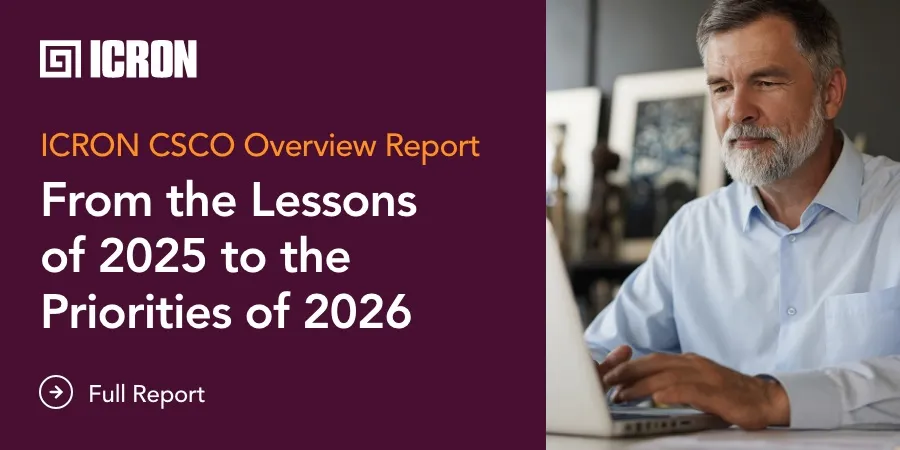
In the supply chain planning and optimization software industry – as is the case in the wider supply chain world – change is the only constant. To survive and succeed, companies that develop these software solutions and deliver them to customers must be able to embrace and embody this change.
Two leaders that have been at the forefront of the development in the supply chain planning and optimization software industry are Dr A. Tamer Ünal – President and Founder of ICRON, a leading provider of Supply Chain Optimization and Optimized Decision Making software solutions – and Dr Jan van Doremalen– Partner and Senior Principal Consultant at CQM (Consultants in Quantitative Methods), a Netherlands-based consultancy that specializes in helping companies transform by optimizing their planning and operations and improving their product and process innovation. ICRON and CQM, founded in 1992 and 1979 respectively, are both well-established firms, and each of them boasts a growing client base that spans the globe and stretches across industries.
Over the past decade, ICRON and CQM have collaborated on numerous projects – most notably on the implementation of a sales and operations planning (S&OP) solution at high-tech equipment manufacturing giant ASML – and the two companies have cultivated a remarkable and fruitful synergy.
In this two-part interview series, we speak with A. Tamer Ünal and Jan van Doremalen, two trailblazers in the world of supply chain planning and optimization solutions, to get their thoughts on how supply chain trends and optimization technologies have evolved over the past 25 years and how they will change in the years to come.
Tell us about your career and your experiences in working with companies in supply chain planning and optimization. How did you get started in the industry?
A. Tamer Ünal (ATU): I founded ICRON in 1992 when I finished my PhD at the University of Southern California and I started working on a scheduling project at a truck company in the US, in Seattle. Since then, I have always had one foot in the academic world and one foot in the business world, as a professor and as the President of ICRON. I always thought one would be incomplete without the other. I wouldn’t be the academic that I would like to be without the work of ICRON, and ICRON would not be what it is today without the academic work that I put into it. They support each other completely.
My PhD was in production scheduling, but the problem I dealt with in my studies was quite academic. As I mentioned earlier, after I graduated I was involved in an industrial project at a truck company. The first meeting I attended there was a surprise for me because I thought I knew about scheduling and planning, but I got a huge shock as I didn’t understand a single word the planning and scheduling guys there at the company were talking about. They were using completely different terminology, and they had different concerns and constraints. At that point, I realized that the problem called “scheduling” in real life and the problem called “scheduling” in academia are two completely different things.
This industrial scheduling problem intrigued me. I realized that what I was studying in the academic world could not be applied directly to real-life situations. There was a gap between academic and real-life scheduling solutions, and I was inspired to bridge that gap.

The crux of the problem is that each separate instance of a planning or scheduling problem in real life is unique, and we need think about how to solve that problem from scratch almost – maybe utilizing what you have already, but you still need to devise a new algorithm for each instance of a scheduling problem. But this process is quite slow, error prone, and costly. Because even if you come up with a good algorithm, to make that algorithm work in an industrial enterprise application setting is costly, requires programming, testing, debugging, etc.
The question for me was: how can I make an algorithmic planning and scheduling system where the all enterprise application bells and whistles (including user interface, integration, and collaboration functions) are already implemented, but also where the scheduling and optimization logic can be embedded into it easily and in a flexible manner for each customer and they can create their own algorithms – without the need for detailed coding or assistance from a computer science expert?
And so I – along with a group of Masters and PhD students – devised such a system, and it was first released in 2000. The system is called GSAMS (which stands for Graphical Scheduling Algorithm Modeling System), and it enables us to go to any company and integrate with their back-end system seamlessly without too much effort, provides a nice user interface for the company’s planner out of the box, gives them the capability to write their own algorithms in a relatively short period of time, and can be embedded easily into their enterprise decision making environment.
When we created GSAMS, there was no other similar system in existence. The uniqueness and beauty of GSAMS is that it doesn’t depend on any specific algorithmic paradigm (such as rule-based, constraint propagation, heuristic, or optimization-based algorithms), but has the flexibility to implement any paradigm you choose for a particular implementation and solve any planning or scheduling problem in the best manner possible.
At that time, we also started conducting research on what happens when we divide and decompose planning and scheduling problems. If we have independent planners solving problems in their own locations, how to they collaborate to ensure there is global consistency?
We did a lot of research on that, and ICRON – as far as I know – is the first actual application that implemented a distributed planning and scheduling environment in real life. This was a revolutionary development at that time, the result of a collaboration academic thinking with enterprise application development.
Now we have quite a number of customers that utilize ICRON’s distribution and collaboration mechanisms to be able to solve their problems, and this distributed and connected architecture gives us flexibility in extending and expanding the usage of the system to meet each company’s needs.
Jan van Doremalen (JVD): My career has been closely linked with CQM. In 1986, after completing my PhD in Mathematics at the Eindhoven University of Technology, I started with CQM. Actually, at that time, CQM was a part of Phillips, but we were focused on using operations research, statistics, and information science to help improve businesses – and that’s still our mission today.

I have always been involved in supply chain management projects. I did my first projects for Phillips, which at the time had a lot of factories in Europe, but wanted to expand to Asia. I did a lot of work in optimizing the operations of their factories as well as optimizing their supply chain network design. With my operations research background, I opted to utilize both optimization models and simulation. We are always talking about optimization, but what we need to do in the supply chain is making decisions under uncertainty. The uncertainty factor is a very important one, that’s why you need scenario analysis and management and simulation capabilities as well as optimization.
After working for Phillips in Europe for four years, I worked for two years in the US, in New York – doing the same type of stuff. All over the world, I saw that people in the business world wanted to jump on the data science train – and I still see this today.
In early 1993, CQM separated from Phillips and formed an independent company after a buy-out. At the start we had only one client – Phillips – but since then we have acquired a wide range of clients from various industries including high-tech and electronics, chemicals, transportation, railways, and agriculture.
Tell us more about your company. How has it evolved and developed over the years? What makes it unique?
ATU: ICRON has grown and developed tremendously since it was established in 1992, and we now have over 100 customers and have done over 500 implementations.
Looking back, I can see that the company has gone through three major phases.
During the first phase, from 1992 to around 2000, we were essentially academics who were trying to solve challenging planning and scheduling problems in real life, for individual customers. Our focus was on solving mathematical problems and providing a good plan or schedule for the planners of each company we worked with.
Then, at some point in mid-2000, we took a look at all the different models we had generated for different customers, and saw that there were some commonalities in the things we do across different sectors, for different customers. We asked ourselves: Can we reduce the complexity of our projects by standardizing certain ideas and solution procedures and data models into a set of products? How can we design a product that will be applicable for a larger group of customers, which will be able to model the commonalities in all these different supply chain problems?
Thus, we entered the second phase of ICRON’s development: standardization and productization. During this phase, we standardized our supply chain models and developed our product, which we called “APSA”. Having this standard platform meant that we didn’t have to go to each new customer and start each project from scratch. There was a foundation in place, and this dramatically reduced the project times and increased the reliability of the system in solving planning and scheduling problems (but, it’s important to note, the system did not lose its flexibility).
We are currently in the third phase of ICRON’s development, which started two years ago. During this phase, we took one step back from the technological perspective, began looking at organizations holistically from a business perspective, and started asking ourselves: How can ICRON have an impact in creating value and enabling companies to achieve their KPIs and business goals?
We realized that what matters is not only how you solve certain planning and scheduling problems, but also the way in which you model how decisions are made within that company. The bottom line of each company is determined by certain decisions that are made at certain times by certain people. So the question is not how I solve a planning or scheduling problem, but how I can make sure that a certain person at a certain time in that company makes the best possible decision.
The new generation of ICRON is concerned with modelling decision points rather than just solving planning and scheduling problems. Modelling a decision involves solving mathematical problems, but also solving data issues, solving organizational issues, and managing communication and collaboration within a company.
In this third phase of ICRON’s development, we are focused on optimizing the decision processes within each company. And an optimized decision process may not need to have a mathematical problem optimally solved. With this decision-centric approach, we are aiming to achieve the optimal behavior of an organization, rather than the optimal solution to a mathematical problem.
JVD: What makes CQM unique is that we have deep expertise. We currently have 35 consultants, and the people that we have are the best in the Netherlands in their respective fields. Furthermore, our people are not only experts in mathematical fields such as operations research or information science, they are also very good at working together and collaborating with others in both the corporate and academic spheres. Indeed, our people are our most important asset.
Essentially, we do three things. First of all, we give advice. For example, if a company is thinking of redesigning their supply chain, we can support them in making models and showing them what would be the best option – and this something that we could do in the ICRON software environment, which would help them with their strategic decision making. Secondly, at the technical level, we do forecasting, inventory management, and, generally speaking, work with companies to set parameters and formulate policies that they should follow – this is a combination of advice and software. Lastly, on the operational level, we build software. For example, we have built transportation planning systems or we have also done this with partners. So we do advice, software, and anything in between and we also do training.
We try to minimize the amount of programming work that we do – and that’s why we work together with ICRON as well as other software providers.
Our sweet spot is the combination of the data analytics, optimization, and simulation. If you look at data science – how it is currently defined – you have the descriptive part, predictive part, and the prescriptive part. We cover all of those. We are very good in the statistics part, and machine and deep learning, and optimization and simulation. We do everything. We go from data to information to insights to optimized decision-making.
For me, each project is new challenge, and the most important thing is to make our solutions work. True business value is making our customers happy. People use our solutions, they are happy with it, and are able to make better decisions.
This is what Tamer and I have in common. We both believe that supply chain management, analytics, and optimization should be focused on supporting better decision making across the supply chain by giving companies information and decision support, and by making it possible for them to have better collaboration with the people around them.
When you started working in the supply chain industry over 25 years ago, what were the main challenges that supply chain companies faced then? How have these challenges changed over the years? What do you see as the main challenges that supply chain companies face today?
ATU: The challenges are the same. Essentially what you are trying to do is to deliver products to your customers, with the appropriate costs and appropriate profitability. The problem is the same.
What has changed is the competitive environment. The expected and possible lead times, in certain processes, have changed. For example, previously, a week for the order promising process was the industry standard, but now you have to provide a due date in a few seconds. So lead times have changed. The process is still there – you still need to quote a due date to your customer, but you are expected to do it faster and more accurately.
The level of competition has changed and has increased, as there are certain boundaries that have been erased over time. Previously, it was more difficult for foreign companies to sell something in a different country. But at some point – because of globalization – things became different because you are supposed to compete with a larger set of competitors in different operating environments. So you have to improve your processes faster.
Interestingly, what has changed is the change itself – the requirement for change for companies has changed. Previously, it was like you were operating in a stable environment so you could have a set up – your customers, your market, your technology, etc. – and you could sustain it for a few years. Now it’s impossible. The change is the process itself. So you can not do the same things that you were doing last and still be profitable. You have to change continuously.
Change is a constant now. In that respect, the definition of a planning and scheduling software implementation has changed. In the past, we defined a system that is stable, and we tried to solve the issues of that stable problem and when we came up with a system that works fine in that business environment, it was a successful project. And that’s how most applications still operate. But what we have seen in time, looking at our customers (there are customers that we have been working with for around 20 years) is that the first thing that is impacted by the changes in their competitive environment, operations, and supply chain structure is their planning, scheduling, and decision making processes. This is the first thing you have to change because then you have to adopt your decision processes to optimally operate in the new environment that you face.
In this respect, planning and scheduling systems should be adaptable to those new operating conditions. You need to be able to implement new algorithms and new logic immediately so that you capitalize on an opportunity and make optimized strategic, tactical, and operational decisions.
Today, planning and scheduling software solutions are not only solving a particular planning and scheduling problem, but also actually serving as a dynamic decision making tool – and we think ICRON, with this perspective, is a nice fit to do that. Because with ICRON you can actually change the logic behind the system very fast, the integration points very fast, and if there are new sources of data that are flowing and you can very quickly expand your data usage and utilize that new data in your decision processes. You can actually open up your interfaces and decision points to other planners and decision makers in your organization as it changes structurally. This flexibility is no longer a nice thing to have, it’s a must have. You cannot have a static logic, which doesn’t give you control over your planning and decisions in today’s changing competitive environment.
JVD: Basically, when you look at the supply chain, there has not been that much change in the basic questions you have to answer. You create capacity, you allocate capacity, you use capacity, and you have a monitoring and feedback system. I think that the challenges today arise from the fact that there is more data available and there’s more technology available. You can optimize your whole supply chain to gain a competitive edge – in fact, you have to do that or risk falling behind.
In today’s business landscape, there are challenges that have been there for over 20 years such as collaboration between different parties across the supply chain (which is very important and very difficult to do from an organizational and technical point of view). This is a challenge that hasn’t been solved. Supply chain collaboration is a key challenge.
Technology creates ever more possibilities to support the day-to-day and longer-term decision making, and if you are not using that technology or thinking about using that technology then you will lose touch with what is happening around it. It’s not that the basic questions have changed – of course everything is bigger, more complex, and more global than ever – it’s that there are more possibilities to optimize to get to better decisions and better collaboration. And there is the challenge: how use all this technology effectively.
S&OP – which is also known in the broader sense as integrated business planning (IBP) – is one of the main ideas here. In the past it was very difficult to integrate and get a complete picture of demand and supply and the production environment, but it’s possible now.
With S&OP, what is see happening is that there is a lot of hype and people are talking about it, and the basic idea of S&OP is a good idea. But the way people are implementing and using it is not optimal, I think. What often happens is that people have the idea that they need to change everything, and also they don’t follow a well-defined roadmap. They don’t ask themselves: Where are we now? Where do we want to be? How do we get there, step by step, and ensure that the organization, the people, the processes, and the systems are ready?
Another challenge is on the data science. How can we get to a data-driven supply chain? That’s popping up as something we should do, but how to do it is a major challenge. How to truly harness the power of your data and utilize it. How can we use our data to make the best decisions or automate the best decisions?
Today there is so much data that is available and accessible. Now it’s possible to handle large data sets and combine them in many ways – this makes a big difference and provides many new opportunities in the optimization area. This data can feed all the optimization technologies.
Also, over the last couple years, there’s been major advancements in machine learning, deep learning, and artificial intelligence (AI). At a more basic level, using all the data that you have to make decisions on what to do next.
Our business is descriptive, predictive, and prescriptive analytics. Nowadays you can work with all the data that is available from different sources, and this creates new technologies – but also raises questions on how to use those technologies in the best way.
You must ensure that the technologies you are using are really delivering insights that are true. One of the issues we see with machine learning and AI-type of applications – which I think are wonderful – at the operational level is the danger of feedback loops. With these technologies, you learn from the past and have to execute that in the present. But it’s difficult to look forward, and adjust your plans and policies based on what might happen or, even better, what you want to happen – this is hard to do with machine learning and AI.
There are so many possibilities, but all of these create technical, organizational, and people challenges. How are people behaving? How can people develop?
In all of our projects, what we really need to think about is the processes and the people that we have to support. It’s our job to steer projects to ensure they are aligned with the company’s business goals. We should have a vision and share it with the management of the company and give them a roadmap of where we want to go to, and then get the people involved and empower them.













